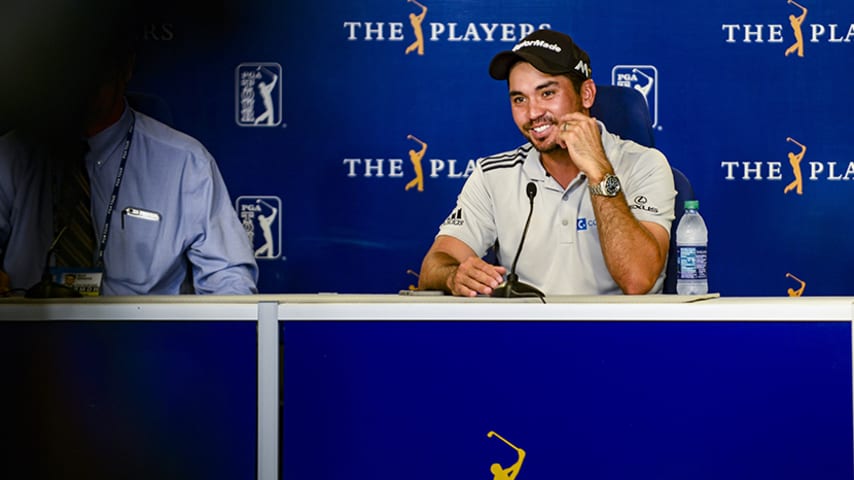Goats at TPC Sawgrass
7 Min Read

The early days of TPC Sawgrass include alligators, snakes, deer – and a herd of extremely useful goats
Written by Bill Fields
The early days of TPC Sawgrass include alligators, snakes, deer – and a herd of extremely useful goats
Everyone who was present at the creation has a story.
Falling into a stinky alligator pit the size of a Chevrolet.
Having the head of a rattlesnake you killed with a machete still stuck in your boot.
Taking in a pet deer.
Walking a narrow trail through wide webs spun by huge Banana spiders.
Getting a goat off the clubhouse roof.
When you see the Stadium Course at TPC Sawgrass during this week's THE PLAYERS Championship in all its emerald splendor—hardly a blade of grass out of place on a stage as well-manicured as any in sport—it is difficult to imagine it any other way.
But the people involved in building the PGA TOUR’s flagship course nearly four decades ago on 415 acres of swamp and forest in Ponte Vedra Beach, Florida, know how wacky, even risky, those formative years were.
“I’d always heard that a snake won’t bite if it’s underwater, but we found out that wasn’t so,” says project manager Vernon Kelly. “One of the surveyors was bitten by a moccasin as he was walking across a ditch. He recovered, but after he’d gotten real sick and had to go to the hospital.”
Once, Kelly nearly stepped on a large rattlesnake as he led course architect Pete Dye, then-PGA TOUR Commissioner Deane Beman and construction foreman Dave Postlethwait off the property at the end of long day.
“I didn’t know Vernon could move so fast,” Beman recalls.
“He mowed everybody down beating it out of there,” Postlethwait says. “It was the first time I saw the Commissioner get beat up.”
Another time, Postlethwait was trailing Kelly, the two talking about alligators. Kelly fell through vegetation into a large hole. “I had just been telling Dave how gators hide their kill and store it in a pit to rot before they eat it,” Kelly says. “Then I dropped into this alligator pit that smelled to high heaven. Dave fell in right behind me. He took off like a rocket, and that was the last time I saw him that day.”
Before Jerry Pate pushed Dye and Beman into the lake on No. 18 and then dove in after winning THE PLAYERS in 1982 -- the first time the tournament was held on the Stadium Course -- Postlethwait and his crew had been swimming there many times. “We’d have races in those lakes after work,” Postlethwait says.
That wasn’t Postlethwait’s only diversion. Bob Dickson, then the club’s marketing director, was asked by a local game warden if the staff could take in a deer that a local family had raised as a pet, an animal who had grown too big for their house and couldn’t live in the wild.
“Magnum” the deer lived in the TPC maintenance compound, where workers fed him milk out of a baby bottle. “He’d follow us around in a cart,” Postlethwait says. “He was our pet. I missed him when somebody stole him.”
Building a course on hostile terrain meant coming to grips with the challenge, whether it was the task of digging through the muck to get to the usable sand to form holes or simply making one’s way from point to point.
“It was a mess, man,” says Postlethwait, who became the first course superintendent. “I carried a machete because there were lots of snakes. I’d see water moccasin and swish ’em away. I got pretty used to walking through all the spiders. It almost became a crazy game. It was bad, but you didn’t want to slow down so you just started plowing through that stuff.”
Bobby Weed, now an architect but who then worked for Dye, was on the job at Long Cove Club in Hilton Head Island, South Carolina, which was being built the same time as TPC Sawgrass. “Pete would drive up from Ponte Vedra and arrive at all hours of the night,” Weed says, “and you could tell the TPC job was just beating him up. I remember him telling me one day that he didn’t know if they could finish the project. But Pete’s always been able to do more with an inferior site than anyone.”
The property Beman famously purchased for one dollar was so inhospitable that when the formal groundbreaking for the course occurred on Feb. 12, 1979, it was held by Highway A1A. “It was staged there by the road because we couldn’t get into the property,” Beman says.
Later, during construction, he recalls that visitors “would be shocked at what they saw when they got to the interior,” so wild was the parcel. “I didn’t have doubts that it could be done, but nobody was sure we could keep it on budget,” Beman says. “I do think it’s unheralded accomplishment. Vernon Kelly was a very, very talented manager. He was a master.”
Kelly and his team accomplished the feat on a relative shoestring budget because TOUR funds weren’t permitted to be spent on TPC Sawgrass. After $1 million was raised by selling charter memberships, a $3 million loan was obtained and additional funds came from proceeds from THE PLAYERS from 1978-82. Beman biographer Adam Schupak reported that the cost of the course, clubhouse and maintenance building, furniture and equipment was just over $6.35 million.
To clean up the large amount of thick underbrush that remained along the playing corridors as the Stadium Course neared its official opening day of Oct. 24, 1980, the club relied on a unusual source of free labor: goats.
“The TOUR had limited funds, and it got to the end of the funds before we were really finished,” says Pete Davison, who was hired as the club’s first head professional in the summer of 1980. “We had to clean up the roughs, and that’s where the goats came in. Pete Dye knew a farmer who had turned some goats loose in a lot of underbrush, and they got rid of it. Pete threw the idea out to Deane, and he went for it.”
There was “Prunes,” “Thor,” “Crew” and their unnamed fellow livestock, which grew to a collection of a couple of dozen goats after acquisitions and births. They weren’t picky about the vegetation they put into their four-chambered stomachs, consuming shrubs, weeds, vines and grass at a hearty clip.
“It was pretty innovative, and in about six or eight months, the goats had cleaned up 80 percent of the problem and we didn’t have to spend a nickel,” Beman says. “They ate everything.”
But the gratis landscaping wasn’t without costs. The goats were wily and didn’t like being penned in. Initially kept to the right of the first fairway --“Goat Island,” Postlethwait called it -- the animals wandered up to the clubhouse, particular on wet evenings.
“They’d kick down the snow fence and spend the night under the porte cochére,” says Dickson. “We’d get there for work early in the morning and they would be there.”
Says Davison, “It would smell like a zoo. They would have done their business, and we’d have to clean it up.”
One young goat had to be rescued after it climbed onto the roof and couldn’t get down. Another time, clubhouse lunchtime diners watched in shock as a small goat drinking at a nearby pond was confronted by an alligator who knocked it into the water with its tail.
“Everybody was watching, horrified, as this precious little goat got overpowered by a gator,” Kelly says. “The gator had it submerged, but all of a sudden the goat popped up, swimming like crazy. Somehow, it made it to shore.”
The diners applauded the kid’s improbable escape, but over time the novelty of having the goats on the property -- “They became celebrities,” Kelly says -- wasn’t enough to override the nuisance they became.
“They had to go, they became such a pain,” says Postlethwait, who gave away the goats about a year after the Stadium Course opened.
But not before the late afternoon when one goat slipped through a propped-open clubhouse door and into the grill room.
“A couple of guys had played golf and were at the bar having a beer or three,” Dickson says. “A waiter shooed the goat back outside pretty quickly, but the two guys saw it. The one said to the other, ‘I’m not telling nobody if you’re not.’ ”




